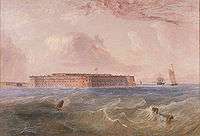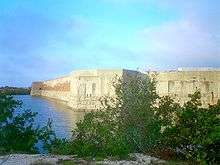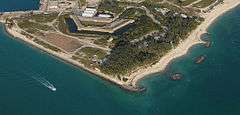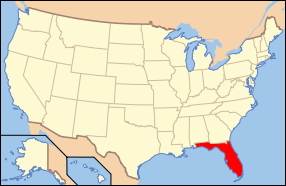Fort Zachary Taylor Historic State Park
|
Fort Zachary Taylor | |
|
Aerial view of Fort Zachary Taylor State Park | |
  | |
| Location | Monroe County, Florida, USA |
|---|---|
| Nearest city | Key West, Florida |
| Coordinates | 24°32′52″N 81°48′35″W / 24.54778°N 81.80972°WCoordinates: 24°32′52″N 81°48′35″W / 24.54778°N 81.80972°W |
| NRHP Reference # | 71000244[1] |
| Significant dates | |
| Added to NRHP | March 11, 1971[1] |
| Designated NHL | May 31, 1973[2] |
The Fort Zachary Taylor Historic State Park, better known simply as Fort Taylor (or Fort Zach to locals) is a Florida State Park and National Historic Landmark centered on a Civil War-era fort located near the southern tip of Key West, Florida.
History of Fort Zachary Taylor

1845–1900
Construction of the fort began in 1845 as part of a mid-19th century plan to defend the southeast coast through a series of forts. The fort was named for United States President Zachary Taylor in 1850, a few months after President Taylor's sudden death in office. Yellow fever epidemics and material shortages slowed construction of the fort, which continued throughout the 1850s. At the outset of the U.S. Civil War in 1861, Union Captain John Milton Brannan seized control of the fort, preventing it from falling into Confederate hands and using it as an outpost to threaten blockade runners. Originally, the fort was surrounded by water on all sides, with a walkway linking it to the island. The fort was completed in 1866, although the upper level of one side was destroyed in 1889 to make way for more modern weapons, with the older cannons being buried within the new outer wall to save on materials. The fort was heavily used again during the 1898 Spanish–American War.

1900–present
In 1947, the fort, no longer of use to the U.S. Army, was turned over to the U.S. Navy for maintenance. In 1968, volunteers led by Howard S. England excavated Civil War guns and ammunition buried in long-abandoned parts of the fort, which was soon discovered to house the nation's largest collection of Civil War cannons. Fort Taylor was therefore placed on the National Register of Historic Places in 1971 and designated a National Historic Landmark in 1973. Due to the filling in of land around the fort, including the creation of an attractive stretch of beach, the park now occupies 87 acres (352,000 m²).
Truman Annex
The fort's land that is closer to downtown Key West became part of the Truman Annex to Naval Air Station Key West. The annex was originally a separate major installation known as Naval Station Key West and, until its closure in 1974, included a submarine base.
President Harry S. Truman used Naval Station Key West for his Winter White House for 175 days in 11 visits. The Secret Service had a private beach built on the land for the president's security, but he reportedly only visited it once, preferring the public beaches. The beach name is called "Truman Beach." The fort, along with its related support buildings, was later renamed for Truman.
Naval Station Key West was decommissioned in 1974 as part of post-Vietnam War force reductions because the U.S. Navy had decommissioned nearly all of their diesel-electric submarines and contemporary nuclear powered submarines were too large for the station's existing port. Most of the then-former naval station became an annex (e.g., Truman Annex) to the remaining Naval Air Station Key West and served as the landing point for many during the 1980 Mariel boatlift of Cuban refugees. Those buildings in the Truman Annex and associated real estate not retained by the U.S. Navy as part of NAS Key West were sold to private developers. There is a museum for the Truman White House and the U.S. Navy continues to own and maintain the piers and that portion of the former Naval Station Key West property to the south of Fort Taylor, primarily in support of Joint Interagency Task Force South (JIATFS) and the Naval Security Group Activity (NAVSECGRUACT Key West).
Current uses
In addition to the role of the fort and its adjacent beach as tourist attractions, Fort Taylor is also the location of a number of annual events, including week-long Civil War reenactments. On the weekend preceding Halloween, it is transformed into a haunted fort, much like a haunted house but on a grand scale and with a distinctive Civil War theme.
- The fort as seen from the Gulf of Mexico
 Picnic area and beach.
Picnic area and beach. Beach
Beach Fort
Fort Outside view of Fort Zachary Taylor, showing the moat.
Outside view of Fort Zachary Taylor, showing the moat. Sunset from park.
Sunset from park. Aerial view showing fort, picnic area and beach.
Aerial view showing fort, picnic area and beach.
Historic Fort Taylor
References
- 1 2 National Park Service (2009-03-13). "National Register Information System". National Register of Historic Places. National Park Service.
- ↑ Fort Zachary Taylor at National Historic Landmarks Program
External links
| Wikimedia Commons has media related to Fort Zachary Taylor. |
- Fort Zachary Taylor at Florida State Parks
- History of Fort Zachary Taylor at Absolutely Florida
- Friends of Fort Taylor website
- Florida Department of State: State Archives of Florida Online Catalog Architectural and technical drawings of Fort Zachary Taylor 1969-1980
- Historic American Buildings Survey (HABS) No. FL-283, "Fort Taylor, Whitehead Spit Vicinity, Key West, Monroe County, FL", 22 photos, 5 data pages, 2 photo caption pages, supplemental material


